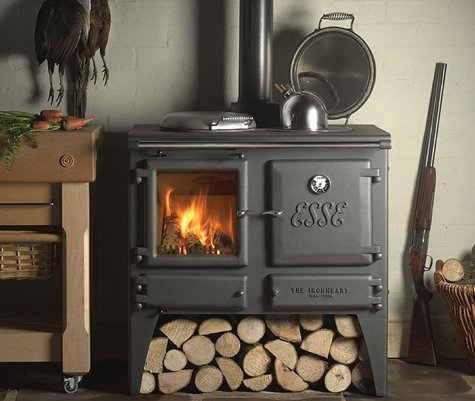TRENDS

Get Cooking with Cook Stoves
In the kitchen of my 1840 farmhouse, an Enterprise wood burning cookstove is the quiet star of the room. The foundry stamp is as crisp as the day some ironworker pressed the year of its birth - 1913. For a century, the stove has not moved from its footprint. And 100 years later, the stove serves as perfectly as it did the day a farmer by the name of Matthew McCullough lugged it home. Even on the coldest of nights, the Enterprise heats me, my food, and my water. Imagine, 100 years and going as strong as ever. In the era of products obsolete or uninvented, the wood burning cookstove is a welcomed anachronism.
Everyone should have one – and not simply to recreate the nostalgia of our grandmother's kitchens. Today's wood cookers are technologically advanced, highly efficient, ecologically sound, and designed with every decor in mind. The ones I like most are the "triple threats," capable of cooking meals, heating the home, and producing hot water. "Wood burning cookstoves are no longer just for antique buffs, but can be one of the wisest ways to plan out a home's cooking, heating and domestic hot water needs," says Patricia Giumarra of Vineyard Hearth Patio & Spa in Vineyard Haven.
But let's start with some basics. If heating the kitchen and occasional cooking are the prime functions required, two familiar Vermont companies make just the ticket. Hearthstone has the "Deva," a slick, enameled wood cooker with the bonus of a fire-view burning box. Vermont Castings has the "Bun-baker," a tall and graceful model with lovely soapstone sides and fire-view burning chamber too. These stoves are in the $4000 range. For those who want the traditional look of grandmother's kitchen, Heartland has several models that blend 19th century looks with 21st century performance. Heartlands are a bit pricey, moving into the $6000 range, but these are true, versatile cooking stoves.
Two European companies – Esse and LaNordica – make the ultimate champions of design sense and practicality. Both produce stoves with boilers. Don't get riled by the word "boiler." These are more aptly called "water jackets," but what they do deserves a standing ovation. In addition to producing convective and radiant heat from the burning box right to the room, the boiler can shunt hot water into radiators, in-floor radiant heat systems, and even provide domestic hot water. LaNordica's several design motifs can fit any style room, from country cottage to sleek stainless steel. The Esse "Ironheart" has a more rustic look, but its massive firebox truly delivers an all-night burn that won't require rekindling in the morning. The LaNordicas and Esses range in cost from about $3500 to $5500, depending upon features.
My favorite is the Pioneer Maid line, founded by an Amish family in Ontario, Canada. Pioneer Maid stoves offer a degree of control undreamed of by grandmother. A simple twist of the twin air-intake knobs and the fire leaps to life. A twirl in the reverse direction and it is almost instantly dampened down. Pioneer Maids are strong and reliable, a true meld of heating and cooking into the same stove. The firebox is prodigious, and the newer models can both top and front load. "The Pioneer Princess" comes in a white, enameled finish, and options include a top warming oven, hot water water reservoir, and water jacket, which can supply radiators, domestic hot water and radiant in-floor heating systems just like the European stoves. Most of all, the cost of the Pioneer Maids is most attractive. At base price in the $2500 range, even the fully tricked out models will come in less than $3600.
"Before you do take the wood cook stove plunge - and you will be happy if you," says Ms. Giumarra. "Check with your local building inspector and insurance agent to make sure you conform to all the required codes."
And then: Get cooking.
Everyone should have one – and not simply to recreate the nostalgia of our grandmother's kitchens. Today's wood cookers are technologically advanced, highly efficient, ecologically sound, and designed with every decor in mind. The ones I like most are the "triple threats," capable of cooking meals, heating the home, and producing hot water. "Wood burning cookstoves are no longer just for antique buffs, but can be one of the wisest ways to plan out a home's cooking, heating and domestic hot water needs," says Patricia Giumarra of Vineyard Hearth Patio & Spa in Vineyard Haven.
But let's start with some basics. If heating the kitchen and occasional cooking are the prime functions required, two familiar Vermont companies make just the ticket. Hearthstone has the "Deva," a slick, enameled wood cooker with the bonus of a fire-view burning box. Vermont Castings has the "Bun-baker," a tall and graceful model with lovely soapstone sides and fire-view burning chamber too. These stoves are in the $4000 range. For those who want the traditional look of grandmother's kitchen, Heartland has several models that blend 19th century looks with 21st century performance. Heartlands are a bit pricey, moving into the $6000 range, but these are true, versatile cooking stoves.
Two European companies – Esse and LaNordica – make the ultimate champions of design sense and practicality. Both produce stoves with boilers. Don't get riled by the word "boiler." These are more aptly called "water jackets," but what they do deserves a standing ovation. In addition to producing convective and radiant heat from the burning box right to the room, the boiler can shunt hot water into radiators, in-floor radiant heat systems, and even provide domestic hot water. LaNordica's several design motifs can fit any style room, from country cottage to sleek stainless steel. The Esse "Ironheart" has a more rustic look, but its massive firebox truly delivers an all-night burn that won't require rekindling in the morning. The LaNordicas and Esses range in cost from about $3500 to $5500, depending upon features.
My favorite is the Pioneer Maid line, founded by an Amish family in Ontario, Canada. Pioneer Maid stoves offer a degree of control undreamed of by grandmother. A simple twist of the twin air-intake knobs and the fire leaps to life. A twirl in the reverse direction and it is almost instantly dampened down. Pioneer Maids are strong and reliable, a true meld of heating and cooking into the same stove. The firebox is prodigious, and the newer models can both top and front load. "The Pioneer Princess" comes in a white, enameled finish, and options include a top warming oven, hot water water reservoir, and water jacket, which can supply radiators, domestic hot water and radiant in-floor heating systems just like the European stoves. Most of all, the cost of the Pioneer Maids is most attractive. At base price in the $2500 range, even the fully tricked out models will come in less than $3600.
"Before you do take the wood cook stove plunge - and you will be happy if you," says Ms. Giumarra. "Check with your local building inspector and insurance agent to make sure you conform to all the required codes."
And then: Get cooking.








